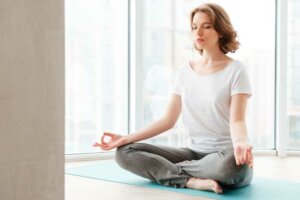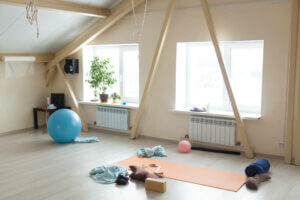Achieving Inner Peace - How to Create a Meditation Space

In a world overloaded with technology, where everyone is in a hurry and short on time, we often feel the need to get away from everything. It’s normal to want to shut yourself away in a meditation space to enjoy the peace and quiet that you don’t get from your daily life.
This is why more and more people are dedicating a small corner of their homes, or even an entire room, to the amazing arts of relaxation, meditation, or yoga. Although many people don’t have much space in their homes, this isn’t a reason to not create a meditation space. Such a space is particularly important if your mind and body need somewhere to relax.
You can convert nearly any space in a home into a personal sanctuary to which you can escape every day. Many interior designers specialize in this type of decoration. However, you can easily achieve this yourself. All you need is a little imagination and a couple of handy tricks.
Meditating at home

Something that started as quite an “eccentric” practice has, little by little, become part of everyday life. Nowadays, meditation is considered to have many physical and mental benefits. Many people are taking advantage of these benefits for the first time.
There’s a good reason to want to include meditation in your daily routine. At the end of the day, a man’s home is his castle. Any home must have a space to get away from the ups and downs of everyday life. Everyone needs a space to find the peace, quiet, and refuge that they need to get up and tackle each day.
Those who practice meditation know how important it is to spend time and effort creating a dedicated space for this. The space should reflect exactly what you want to achieve in your meditation.
Creating a meditation space – location, location, location

It’s important to take time and effort when choosing the location of your meditation space. While you might have “dead spaces” in your home that seem ideal for meditation, there are several factors to consider before choosing the right one.
Meditation requires a great deal of concentration. By trying to meditate somewhere busy in your home where there’s a lot of background noise, you could be setting yourself up to fail before you’ve started.
The best place to meditate is somewhere you can get away from the hubbub in your home, as well as the comings and goings of visitors. In other words, you need a room or an area where you can shut the door to the rest of your home. You need somewhere you can protect your privacy, maintain peace, and keep out the noise.
These three things are important to be able to relax and carry out your meditation effectively. No matter if you choose your bedroom, your home office, or a corner in your garage, the most important thing is that everyone in your home respects your meditation spot. Your family and friends must treat it as a private and protected space.
What should a meditation space look like?

Once you’ve decided where to put your meditation space, the next question is how to set it up to get the most out of it. A meditation space is somewhere to work on your emotions, and so it should be a naturally inspirational and peaceful place.
While it should also be a comfortable space, it’s important to think beyond just your cushions or yoga mat. Lighting, colors, textures, visual aspects, smells… anything that awakens your senses is an important factor to consider. These elements give off energy, and so using Feng Shui can be very helpful.
Yoga and meditation are practices that connect us, as individuals, to the rest of the universe. It’s therefore important to create a meditation space that is carefully designed. It should also be visually stimulating and free of anything unnecessary.
Creating a Zen mediation space

This doesn’t mean that your meditation space needs to be like a Tibetan monastery. However, it’s best to use only what’s strictly necessary. This is why Zen-inspired interior design could be your best friend. These designs are based on using carefully chosen pieces rich in color, textures, and forms. They also use quality materials and visual elements that evoke a sense of peace and calm
You could start by choosing a focal point in your space, such as an architectural structure like a window or a specific corner of your room. If there’s no particular component that stands out, you can create your focal point.
You can achieve this using a yoga image, a mandala, a Buda, an image of the god Ganesh, some Tibetan bowls, or any piece that you find inspiring. You could also use a work of art, a mirror, or simply draw all focus to a blank wall to make it the standout structure of your space.
Lighting your meditation space

Lighting is also an important factor to consider. Your space doesn’t necessarily need natural light, as people usually meditate in the early hours or just before going to sleep when there isn’t much natural light anyway. Meditation before bed is very beneficial, as it increases the levels of certain hormones that are important to our physical and mental health.
Lighting in a mediation space should be soft. It’s important to avoid bright lights, if possible. You can achieve soft lighting by using adjustable lamps, candles, or candle lamps. The idea is to incorporate the shadow patterns of your lighting into the design of your meditation space.
Color and decoration in your meditation space

The art of meditation originates from oriental traditions, and so it’s a great idea to use elements that evoke Indian or Tibetan designs in your meditation space. Nature can also play an important role. Rocks, plants, branches, or even elements such as water, can give character to your space.
Nature can also be very inspiring when it comes to choosing the colors of your meditation space. It’s best to avoid overly loud colors, opting instead for darker or medium tones. White evokes a fresh and clean feeling, and so it’s always a popular color. However, it’s best to avoid very bright shades in your meditation space, as these might distract you from your internalization.
When you want to use your meditation to connect with nature and natural light, you could move to the garden or an open terrace. Just remember to keep away from external noise to avoid it disturbing you.